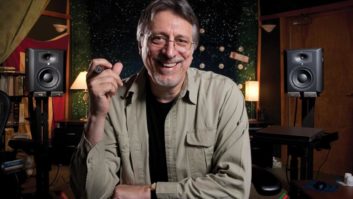After Frank Filipetti’s earlier column where he mentioned his favorite mics, the METAlliance has gotten a lot of questions from readers all essentially asking the same thing: What’s a good way to compare and evaluate studio microphones when trying to choose what’s best for the application and artist? Here’s one of a number of methods as used by Frank and also George Massenburg, who comments here.
The important thing to consider before you start is to ensure that the test is truly fair, and that means you have to compare the mics using the most similar audio path possible. You can spend 10 minutes setting up mics and listen for an hour and not understand what you hear. Spending more time making sure you have a valid comparison, and then listening will usually be more productive.
How does one test microphones?
We’ve seen folks line up four or five mics in a row, and then have their singer sing into each one. The problem with this approach is that you are combining the mic’s performance with the singer’s performance. A great emotional line on a so-so mic will trump a so-so line on a great mic.

Step One: Line up the capsules on, say, four mics and have the singer sing equidistant from each of the capsules. That way, it’s four mics and four tracks, but one performance.
Step Two: You have to ensure you have exactly the same signal chain. Keep it simple—go with maybe just a preamp, and remember, you are not auditioning preamps. The best way to guarantee that all four preamps are identical is measure each of them, or maybe even use a digital mic pre-set to the named gain. Right now, you’re only interested in the difference between the mics, not the pre.
Step Three: Record the performance on all four microphones simultaneously. Look for the record level on all four to be within a decibel or so of each other—and if they’re not equal, now’s the time to adjust playback levels, not mic pre gain. They don’t have to be precisely identical (at least not yet).
Step Four: Select the recorded lines you want to use. It’s best if you use a fairly soft and a fairly loud section.

Step Five: Place an LUFS meter across each section and make sure all four mics play back at identical levels. Frank generally uses -24 as his reference on the soft vocal and -16 on the loud, but use whatever you wish, as long as all four selections are within 0.1 dB. You can accomplish this using your playback gain controls, or if you’re in Pro Tools, maybe use clip gain.
Step Six: Select a short region—a line or two—to listen to. We find it best if you keep the selection short, while giving a second or so to rest between playbacks. This clears the mental “palate,” so to speak, and allows the performance to sink in.
Step Seven: By the way, now’s the time to invite the artist to listen to the different mics with you. While listening to each track, you will try not to listen so much “analytically” (as an engineer), but emotionally (as a producer). If you listen analytically, you are going to miss the emotional picture, and in the end, that’s what we are trying to capture. (Also, George always rarely ignores the artists’ choice).
METAlliance • www.metalliance.com
About Frank Filipetti
Multiple Grammy-winner Frank Filipetti’s credits include Number One singles as Foreigner’s “I Want to Know What Love Is” and “I Don’t Want to Live Without You” (which he also produced), KISS’ “Lick It Up” and The Bangles’ “Eternal Flame.” He’s worked with acts ranging from Korn and Fuel to Barbra Streisand and Elton John, and has also produced, recorded or mixed albums for Carly Simon, George Michael, Dolly Parton, Rod Stewart, Luciano Pavarotti and James Taylor, among many others.
About George Massenburg
Grammy and TEC Award-winner George Massenburg is a producer, recording engineer and designer of audio equipment who has participated in the creation of more than 450 albums. He has won Grammys as both a producer and as an engineer, and in 1998 was awarded a Grammy for Technical Achievement for a lifetime of contributions to the art and science of recording. Massenburg’s discography includes seven Little Feat albums; seven Earth, Wind & Fire albums; 13 Linda Ronstadt albums; and albums with Journey, James Taylor, Jennifer Warnes and Ricky Skaggs, among others. He also created that mainstay of the recording process, the parametric equalizer.
About The METAlliance
The METAlliance—Al Schmitt, Chuck Ainlay, Ed Cherney, Elliot Scheiner, Frank Filipetti and George Massenburg—has the dual goals of mentoring through “In Session” events, and conveying to audio professionals and semi-professionals our choices for the highest quality hardware and software by shining a light on products worthy of consideration through a certification process and product reviews in this column. Its mission is to promote the highest quality in the art and science of recording music.







